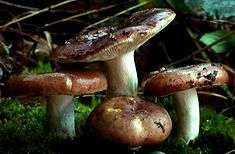Russula vesca
| Russula vesca | |
|---|---|
 | |
| Scientific classification | |
| Kingdom: | Fungi |
| Division: | Basidiomycota |
| Class: | Agaricomycetes |
| Order: | Russulales |
| Family: | Russulaceae |
| Genus: | Russula |
| Species: | R. vesca |
| Binomial name | |
| Russula vesca Fr. (1836) | |
| Russula vesca | |
|---|---|
|
| |
| gills on hymenium | |
|
cap is convex or flat | |
| hymenium is free | |
| stipe is bare | |
| spore print is white | |
| ecology is mycorrhizal | |
| edibility: edible | |
Russula vesca, known by the common names of bare-toothed Russula or the flirt, is a basidiomycete mushroom of the genus Russula.
Taxonomy
Russula vesca was described, and named by the eminent Swedish mycologist Elias Magnus Fries (1794–1878). The specific epithet is the feminine of the Latin adjective vescus, meaning "edible".[1]
Description
The skin of the cap typically does not reach the margins (resulting in the common names). The cap is 5–10 cm wide,flat, convex, or with slightly depressed centre, weakly sticky, colour brownish to dark brick-red. Taste mild. Gills close apart, white. The stipe narrows toward the base, 2–7 cm long, 1.5–2.5 cm wide, white. It turns deep salmon when rubbed with iron salts (Ferrous sulfate).[2] The spore print is white.
Distribution and habitat
Russula vesca appears in summer or autumn, and grows primarily in deciduous forests in Europe, and North America.[3]
Edibility
Russula vesca is considered edible and good, with a mild nutty flavour. In Russia and Finland it is considered entirely edible even in the raw state.
See also
References
- "Danske storsvampe. Basidiesvampe" [a key to Danish basidiomycetes] J.H. Petersen and J. Vesterholt eds. Gyldendal. Viborg, Denmark, 1990. ISBN 87-01-09932-9
External links
| Wikimedia Commons has media related to Russula vesca. |